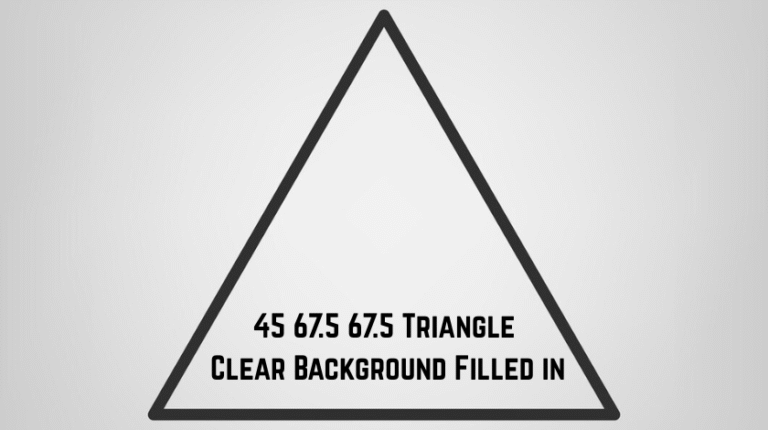Understanding the 45-67.5-67.5 triangle is essential in both geometry and graphic design, especially when used in digital illustrations, architectural layouts, educational diagrams, and vector graphic editing. This unique isosceles triangle with angles of 45°, 67.5°, and 67.5° offers distinct mathematical and visual characteristics. When combined with a clear background and a filled-in body, this shape becomes a critical asset in clean visual presentations and scalable graphics.
In this detailed guide, we explore every aspect of the 45-67.5-67.5 triangle: from its geometric properties and trigonometric applications to creating vector shapes with transparent backgrounds and filled-in interiors.
Understanding the Geometry of the 45-67.5-67.5 Triangle
The triangle in question is an isosceles triangle, meaning it has two equal angles and two equal sides. In this case:
-
One angle = 45 degrees
-
Two angles = 67.5 degrees each
This triangle is not a standard right triangle, and its uniqueness lies in the sum of its internal angles:
45° + 67.5° + 67.5° = 180°
The 45° angle serves as the apex (top point), while the base angles of 67.5° form the broader support. This results in a tall, sharp design that is useful in directional indicators, UI/UX icons, arrowheads, and minimalist architectural models.
Trigonometric Properties and Side Ratios
To compute side lengths relative to angles, we use the Law of Sines:
asinA=bsinB=csinC\frac{a}{\sin A} = \frac{b}{\sin B} = \frac{c}{\sin C}
Assuming side opposite the 45° angle is a, and sides opposite 67.5° angles are b, we get:
asin(45)=bsin(67.5)\frac{a}{\sin(45)} = \frac{b}{\sin(67.5)}
This provides precise ratio values, useful in programming contexts where SVG or CSS polygon points need exact coordinates. This triangle can be efficiently scaled without distortion, which is a core requirement for responsive web design and vector illustrations.
Applications of the 45-67.5-67.5 Triangle
This triangle is commonly used in:
-
Architectural renderings where asymmetrical angles offer a modernist visual
-
Digital logos and branding, especially in tech and design industries
-
Mathematics educational materials, helping students understand non-right triangles
-
CAD software and 3D modeling for precise angular modeling
-
Infographics and vector icons, especially in navigation arrows or stylized pointers
When rendered with a clear background and filled-in shape, this triangle becomes a flexible element for both print and digital platforms.
Creating a 45-67.5-67.5 Triangle with Clear Background and Fill
In Adobe Illustrator (or any vector design software)
-
Set Canvas Background to Transparent:
-
Go to File > Document Setup and check “Transparent Background”.
-
-
Draw the Triangle:
-
Use the Polygon Tool and set sides to 3.
-
Rotate the triangle and manually adjust its corners to match angle degrees using the Transform Panel.
-
-
Set Fill Color:
-
Choose a solid fill (e.g., hex code
#000000for black). -
Make sure stroke is removed for clean design.
-
-
Verify Angle Precision:
-
Use Smart Guides or angle measurement tools to lock in 67.5° on base angles and 45° at the apex.
-
-
Export with Clear Background:
-
File > Export > Save for Web (Legacy) > PNG-24 with transparency checked.
-
How to Calculate Coordinates for Precise SVG Drawing
To get the exact coordinate points for a 45-67.5-67.5 triangle:
-
Assume side AB = BC (since it’s isosceles).
-
Use trigonometric functions to derive the height and base length.
Let’s assume base = 100 units:
-
Height (h) can be calculated using:
h=a⋅sin(67.5°)h = a \cdot \sin(67.5°)
-
Half the base = 50 units
-
Point A (apex) = (50, 0)
-
Point B = (0, h)
-
Point C = (100, h)
This allows for exact plotting in SVG or any canvas-based environment.
Why Clear Backgrounds Matter in Triangle Graphics
When we speak of a “clear background”, we’re referring to a transparent canvas—crucial for:
-
Layering graphics without white boxes
-
Using in presentations or overlays
-
Embedding into websites and apps seamlessly
-
Designing adaptive logos and icons
A triangle with a filled-in color and a transparent background retains visual clarity on any platform, whether it’s dark UI or light-themed pages.
Triangle Fill Types: Solid, Gradient, and Pattern
Solid Fill:
Most commonly used for clear visual impact. Use hexadecimal colors like:
-
#FFFFFF(white) -
#000000(black) -
#FF5733(vivid orange)
Gradient Fill:
A more modern look can be achieved using linear or radial gradients, especially in:
Pattern Fill:
In Illustrator or CSS SVGs, patterns can be used for stylization crosshatch, dots, stripes ideal for educational or stylized branding assets.
Exporting and File Types for Clean Triangular Graphics
-
PNG-24: Best for preserving transparency.
-
SVG: Scalable, editable, best for web.
-
EPS: Industry standard for print, maintains vector fidelity.
-
WebP: Modern web format, supports transparency and compression.
Always export at high resolution (300 DPI for print, 72 DPI for web) to ensure the triangle remains crisp at all sizes.
Using the Triangle in Web and UI Projects
The 45-67.5-67.5 triangle with a clear background is perfect for:
-
Next/Previous buttons in carousels
-
Tooltip pointers or speech bubble accents
-
Visual separators in modern web layouts
-
Background design fragments that blend into layered designs
When paired with CSS animations, such triangles can be used as attention-grabbing hover effects or directional cues.
Final Thoughts
The 45-67.5-67.5 triangle is more than a mathematical construct it’s a versatile design element with practical applications across digital, educational, and artistic domains. When created with clear backgrounds and filled-in bodies, it offers maximum flexibility, precision, and aesthetic harmony.
Whether you’re coding with SVG, drawing in Illustrator, or teaching trigonometry, this triangle delivers clarity, uniqueness, and mathematical elegance.

